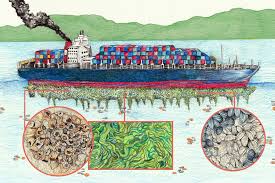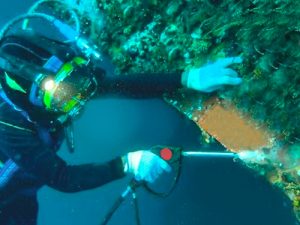Biofouling, the accumulation of marine organisms on ship hulls, is a persistent challenge in the maritime industry. From microscopic algae to barnacles and mussels, these aquatic organisms attach to submerged surfaces, creating significant operational and environmental issues. This article delves into the causes, consequences, and innovative solutions for managing biofouling, helping shipowners improve efficiency, reduce emissions, and comply with international maritime regulations.
Causes of Ships’ Biofouling
Biofouling occurs when marine organisms adhere to submerged surfaces, particularly ship hulls, propellers, and other underwater structures. The process begins with the formation of a biofilm—a thin layer of microorganisms such as bacteria and diatoms. Over time, larger organisms like barnacles, mussels, and seaweed colonize the surface, creating dense and stubborn layers.
Key Factors Contributing to Biofouling
- Water Temperature and Salinity: Warm, nutrient-rich waters accelerate biofouling growth.
- Ship Speed and Idle Time: Ships docked or operating at low speeds experience higher fouling rates.
- Hull Surface Texture: Rough or damaged hull surfaces provide better adhesion points for marine organisms.
- Geographic Operating Areas: Tropical and subtropical regions present higher biofouling risks due to their marine biodiversity.
Consequences of Ships’ Biofouling
Biofouling impacts ship performance, operational efficiency, and environmental sustainability. Its effects include:
1. Increased Fuel Consumption: The roughened hull surface caused by biofouling increases hydrodynamic resistance, forcing ships to consume more fuel to maintain speed. According to the International Maritime Organization (IMO), severe fouling can increase fuel consumption by up to 40%, translating into higher operating costs and increased CO2 emissions.
2. Spread of Invasive Species: Biofouling is a significant vector for the transfer of invasive aquatic species between marine ecosystems. Ships travelling across global routes unintentionally introduce non-native organisms to new environments, disrupting local biodiversity. For example, the zebra mussel (Dreissena polymorpha), native to Eastern Europe, has spread across North America through fouling on ship hulls and ballast water discharge.
3. Maintenance and Dry-Docking Costs:Frequent hull cleaning and maintenance become necessary to control biofouling. These processes require dry-docking, which is costly and time-consuming, causing operational delays.
4. Regulatory and Legal Implications: Compliance with international regulations on biofouling management is mandatory. Ships failing to meet these standards face port detentions, fines, and increased inspections.
International Biofouling Regulations For Ships
The IMO has introduced guidelines under its Biofouling Management Convention to minimize biofouling’s environmental impact. Key regulatory frameworks include:
- IMO Guidelines for the Control and Management of Ships’ Biofouling (MEPC.207(62)): Recommends best practices for biofouling management, including regular cleaning and the use of anti-fouling systems.
- Anti-Fouling Systems (AFS) Convention: Restricts the use of harmful anti-fouling paints containing toxic chemicals like tributyltin (TBT).
- National Regulations: Countries such as Australia and New Zealand have stricter biofouling inspection regimes for incoming vessels.
Innovative Solutions for Managing Biofouling of Ships
Advancements in marine technology have led to the development of effective biofouling management strategies. These include:
1. Anti-Fouling Coatings
Modern anti-fouling coatings prevent marine organisms from adhering to hull surfaces through chemical or physical means.
- Biocidal Coatings: Contain active ingredients that deter marine life. While effective, environmental concerns limit their use.
- Non-Biocidal Coatings: Use advanced polymers to create ultra-smooth, non-stick surfaces that minimize fouling.
Example: International Paint’s Intersleek 1100SR coating reduces fouling and cuts fuel consumption by up to 10%.
2. Hull Cleaning Robots
Automated hull cleaning robots equipped with brushes and high-pressure water jets remove biofouling without dry-docking. These systems operate underwater, reducing downtime and environmental contamination. Case Study: The HullWiper robotic cleaner has been successfully deployed in major ports worldwide, enhancing cleaning efficiency while minimizing ecological disruption.
3. UV-C Light Technology
UV-C light-emitting devices installed near hull surfaces disrupt biofilm formation, preventing the initial stage of biofouling development.
4. Electrolytic Systems
Electrolytic systems use electric currents to repel fouling organisms, reducing their attachment to ship hulls and water intake systems.
5. Air Bubble Curtains
Air bubble systems create a continuous stream of bubbles along the ship’s hull, preventing marine organisms from settling. This technology is still under development but shows promising potential.
Economic and Environmental Benefits of Biofouling Management
Implementing biofouling management strategies yields significant economic and environmental benefits:
- Fuel Savings: Reduced hull resistance decreases fuel consumption, lowering operational costs and carbon emissions.
- Extended Maintenance Intervals: Effective biofouling control minimizes the need for frequent dry-docking and cleaning.
- Compliance and Market Access: Meeting international biofouling regulations ensures uninterrupted market access and smooth port operations.
- Environmental Protection: Controlling biofouling helps preserve marine ecosystems by preventing the spread of invasive species.
Biofouling is a hidden but formidable challenge for the maritime industry, impacting ship performance, operational costs, and environmental sustainability. With stringent international regulations and the rising demand for eco-friendly shipping, proactive biofouling management has become a necessity. Through innovative technologies, international collaboration, and adherence to best practices, the maritime industry can mitigate biofouling’s impact while advancing toward a cleaner, more efficient future.
————————————————
FAQ on Biofouling in the Maritime Industry
What is Biofouling?
Biofouling is the accumulation of marine organisms—such as algae, barnacles, and mussels—on submerged surfaces like ship hulls, propellers, and underwater structures. It begins with a biofilm of microorganisms and progresses into larger, stubborn growths that impact vessel performance.
Why is Biofouling a Problem for Ships?
Biofouling increases hydrodynamic drag, leading to:
-
Higher fuel consumption (up to 40% more in severe cases)
-
Increased CO₂ emissions
-
Spread of invasive species (e.g., zebra mussels)
-
More frequent maintenance and dry-docking costs
-
Regulatory non-compliance risks
What Factors Influence Biofouling Growth?
Key factors include:
-
Water temperature & salinity (warmer, nutrient-rich waters accelerate growth)
-
Ship speed & idle time (stationary or slow-moving ships foul faster)
-
Hull surface texture (rough surfaces attract more organisms)
-
Geographic operating areas (tropical regions pose higher risks)
What Are the International Regulations on Biofouling?
The IMO (International Maritime Organization) has established guidelines, including:
-
Biofouling Management Guidelines (MEPC.207(62)) – Recommends best practices for hull cleaning and anti-fouling systems.
-
Anti-Fouling Systems (AFS) Convention – Bans toxic coatings like TBT (tributyltin).
-
National regulations (e.g., Australia and New Zealand enforce strict biofouling inspections).
What Are the Best Solutions for Managing Biofouling?
Innovative solutions include:
-
Anti-Fouling Coatings – Biocidal and non-biocidal paints (e.g., Intersleek 1100SR).
-
Hull Cleaning Robots – Automated underwater cleaning (e.g., HullWiper).
-
UV-C Light Technology – Prevents biofilm formation.
-
Electrolytic Systems – Uses electric currents to repel organisms.
-
Air Bubble Curtains – Experimental but promising for fouling prevention.
How Does Biofouling Impact Fuel Efficiency?
A fouled hull increases drag, forcing ships to burn up to 40% more fuel to maintain speed. Effective biofouling management can reduce fuel consumption by 5-10%, cutting costs and emissions.
Can Biofouling Spread Invasive Species?
Yes. Ships transport non-native organisms across oceans, threatening marine ecosystems. For example, zebra mussels have invaded North American waters via ship hulls.
What Are the Economic Benefits of Biofouling Control?
-
Lower fuel costs (reduced drag improves efficiency)
-
Fewer dry-docking needs (extends maintenance intervals)
-
Regulatory compliance (avoids fines and port detentions)
-
Environmental sustainability (reduces carbon footprint)
How Often Should Ships Clean Their Hulls?
The frequency depends on:
-
Operating conditions (high-risk areas need more frequent cleaning)
-
Coating type (advanced anti-fouling paints last longer)
-
IMO & port state requirements
Are Eco-Friendly Biofouling Solutions Available?
Yes! Non-toxic coatings, robotic cleaners, and UV-C systems minimize environmental harm while keeping hulls clean.
Conclusion
Biofouling is a major challenge for the maritime industry, but with advanced coatings, robotic cleaning, and regulatory compliance, shipowners can improve efficiency, cut costs, and protect marine ecosystems.
Read more :
Ship Hull Maintenance and Cleaning: Cutting Costs and Emissions




